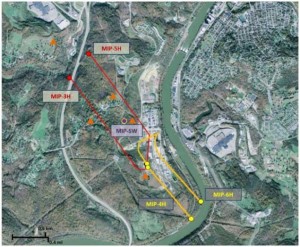ABSTRACT ~ Marcellus Shale Energy & Environment Laboratory (MSEEL) Final Report
The objective of the Marcellus Shale Energy and Environment Laboratory (MSEEL) was to provide a long-term field site to develop and validate new knowledge and technology to improve recovery efficiency and minimize environmental implications of unconventional resource development.
MSEEL initiated in October 2014 and completed in September 2021. Total project value was $29,765,067, support from the US Department of energy totaled $16,608,355 with a cost share of $13,156,712 primarily from Northeast Natural Energy.
This report in a departure from previous reports summarizes the overarching results and outlines the approach taken. We cover two recent efforts in machine learning and reservoir characterization and simulation.
Numerous quarterly reports, public presentations and numerous external publications cover specific results by subtopic and in detail. Publications are listed in the Appendix.
The MSEEL project directly supported at least 110 personnel consisting of 23 tenure track faculty member, 27 research associates (Post-doctoral candidates and other research staff such as research professors), 42 graduate students (Masters and Doctoral), and 18 undergraduates. In addition, data are used at several institutions to educate the next generation of subsurface geoscientists.
From 2015 through December 2021, at least 333 publications are directly attributable to the Marcellus Shale Energy and Environment Lab (MSEEL) or use data or results obtained from MSEEL. The scientific and technical results have significantly improved our understanding of the environmental impacts and subsurface understanding of unconventional shale gas reservoirs such as the Marcellus Shale, and have broad impacts beyond shale gas to include geothermal production and carbon storage.
This report summarizes the overarching results and outlines the approach taken. Numerous quarterly reports, public presentations, and external publications cover specific results by subtopic and in detail. While MSEEL is not currently active, the results and data remain available through the National Energy Technology Laboratory Energy Data eXchange (EDX) (https://edx.netl.doe.gov/), and at the MSEEL website (http://www.mseel.org/).
Available data totals approximately 108 terabytes. Results and data continue to be incorporated into ongoing projects including Science-informed Machine Learning to Accelerate Real-Time (SMART) (https://edx.netl.doe.gov/smart/). Research on machine learning for improved production efficiency with LANL through the SMART Initiative continues and we have provided data and consultation and have contributed papers on use of artificial intelligence for a better understanding of reservoir properties.

